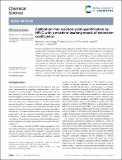Calibration-free reaction yield quantification by HPLC with a machine-learning model of extinction coefficients
Author(s)
McDonald, Matthew A.; Koscher, Brent A.; Canty, Richard B.; Jensen, Klavs F.
DownloadD4SC01881H.pdf (955.2Kb)
Publisher with Creative Commons License
Publisher with Creative Commons License
Creative Commons Attribution
Terms of use
Metadata
Show full item recordAbstract
Reaction optimization and characterization depend on reliable measures of reaction yield, often measured by high-performance liquid chromatography (HPLC). Peak areas in HPLC chromatograms are correlated to analyte concentrations by way of calibration standards, typically pure samples of known concentration. Preparing the pure material required for calibration runs can be tedious for low-yielding reactions and technically challenging at small reaction scales. Herein, we present a method to quantify the yield of reactions by HPLC without needing to isolate the product(s) by combining a machine learning model for molar extinction coefficient estimation, and both UV-vis absorption and mass spectra. We demonstrate the method for a variety of reactions important in medicinal and process chemistry, including amide couplings, palladium catalyzed cross-couplings, nucleophilic aromatic substitutions, aminations, and heterocycle syntheses. The reactions were all performed using an automated synthesis and isolation platform. Calibration-free methods such as the presented approach are necessary for such automated platforms to be able to discover, characterize, and optimize reactions automatically.
Date issued
2024-05-29Department
Massachusetts Institute of Technology. Department of Chemical EngineeringJournal
Chemical Science
Publisher
Royal Society of Chemistry
Citation
Chem. Sci., 2024,15, 10092-10100
Version: Final published version
ISSN
2041-6539
Collections
The following license files are associated with this item: